Abstract
Daughter strand gaps are secondary lesions caused by interrupted DNA synthesis in the proximity of UV-induced pyrimidine dimers. The relative roles of DNA recombination and de novo DNA synthesis in filling such gaps have not been clarified, although both are required for complete closure. In this study, the Escherichia coli E486 and E511 dnaE(Ts) mutants, in which DNA polymerase I but not DNA polymerase III is active at 43 degrees C, were examined. Both mutants demonstrated reduced gap closure in comparison with the progenitor strain at the nonpermissive temperature. These results and those of previous studies support the hypothesis that both DNA polymerase I and DNA polymerase III contribute to gap closure, suggesting a cooperative effort in the repair of each gap. Benzoylated, naphthoylated diethylaminoethyl-cellulose chromatography analysis for persistence of single-strand DNA in the absence of DNA polymerase III activity suggested that de novo DNA synthesis initiates the filling of daughter strand gaps.
Full text
PDF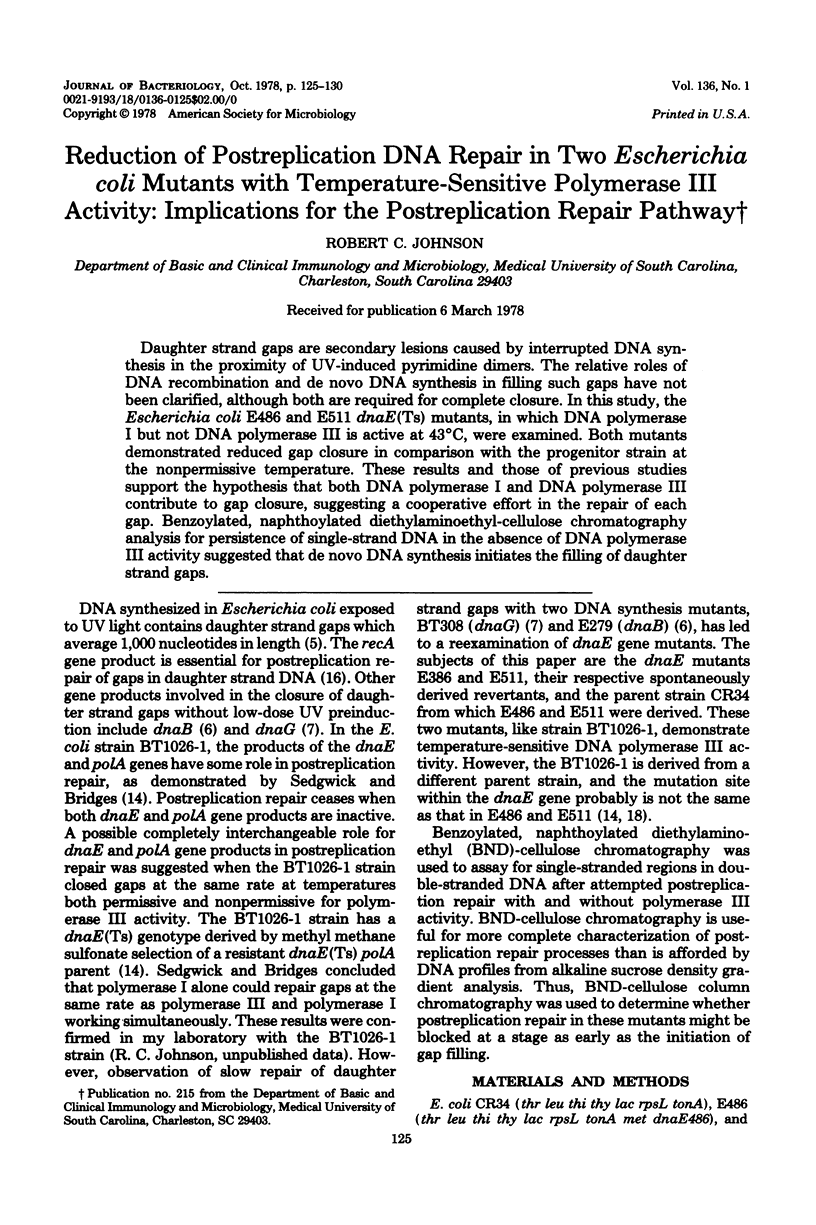
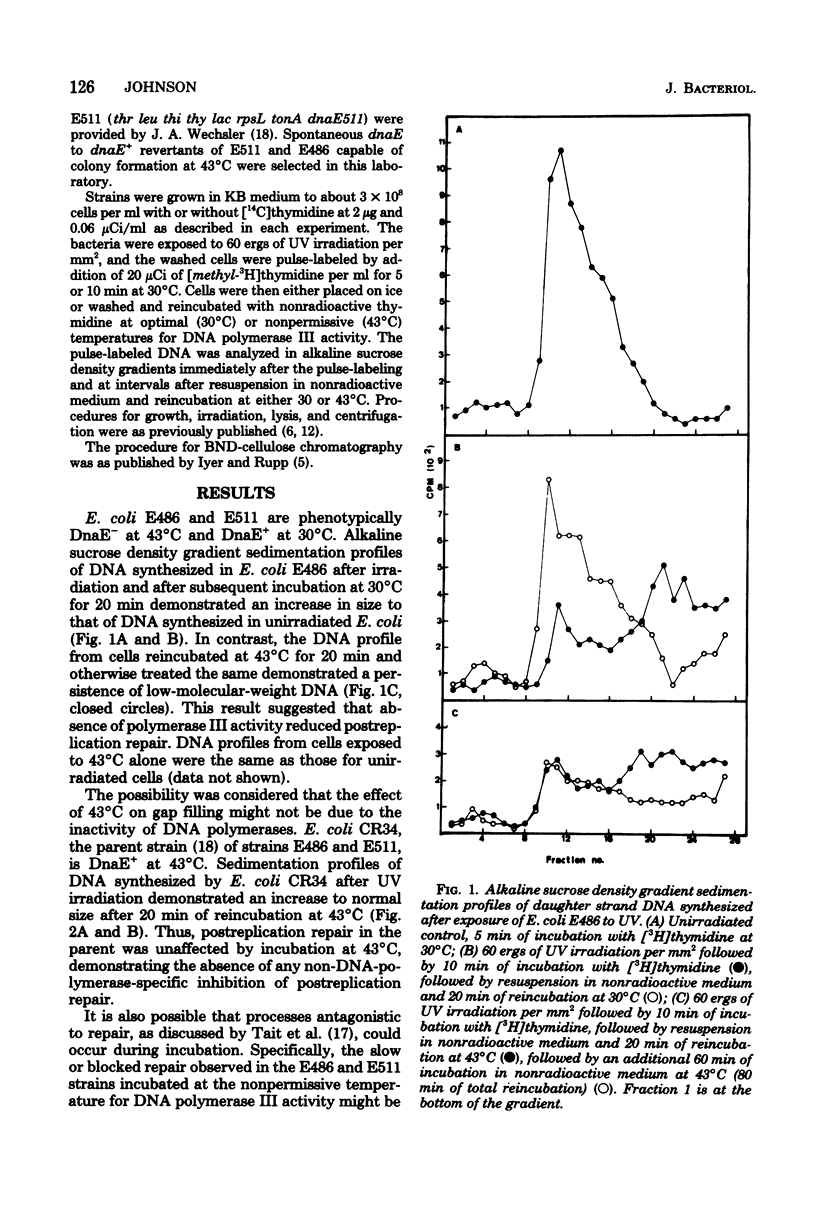
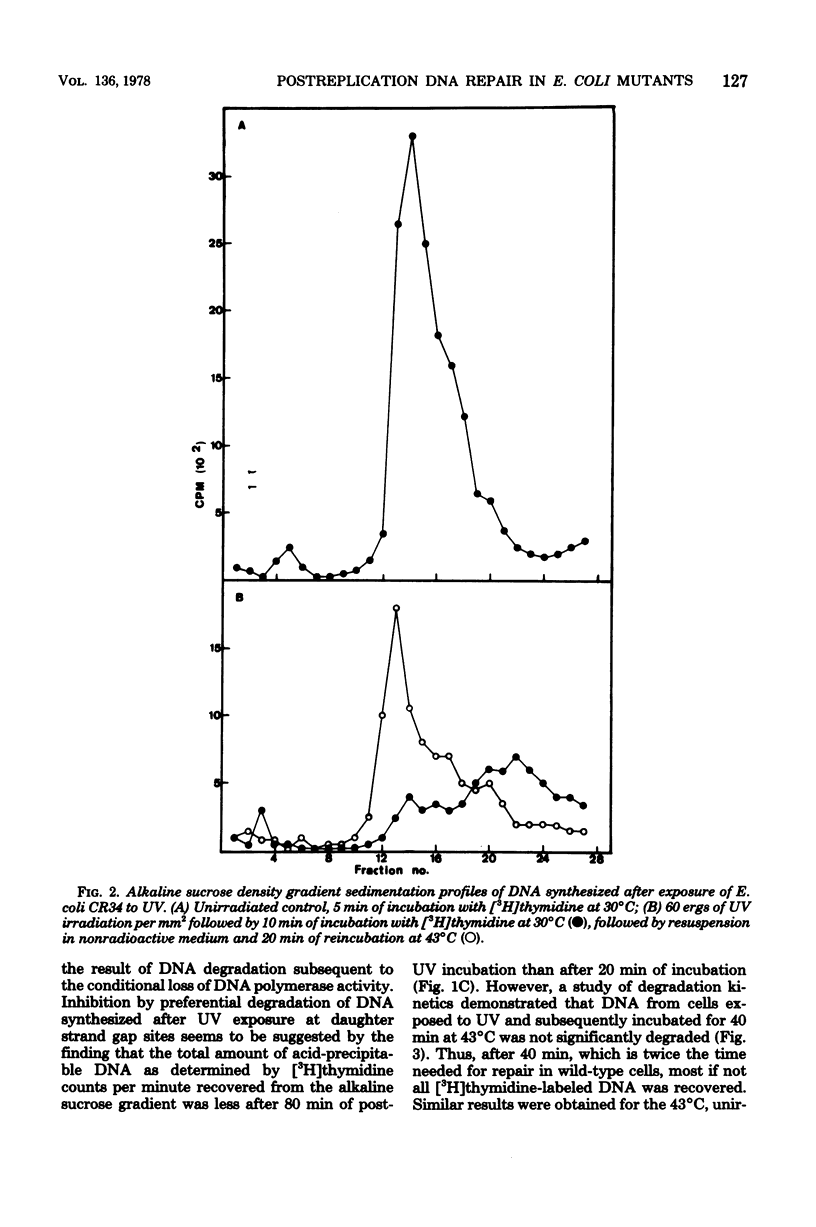
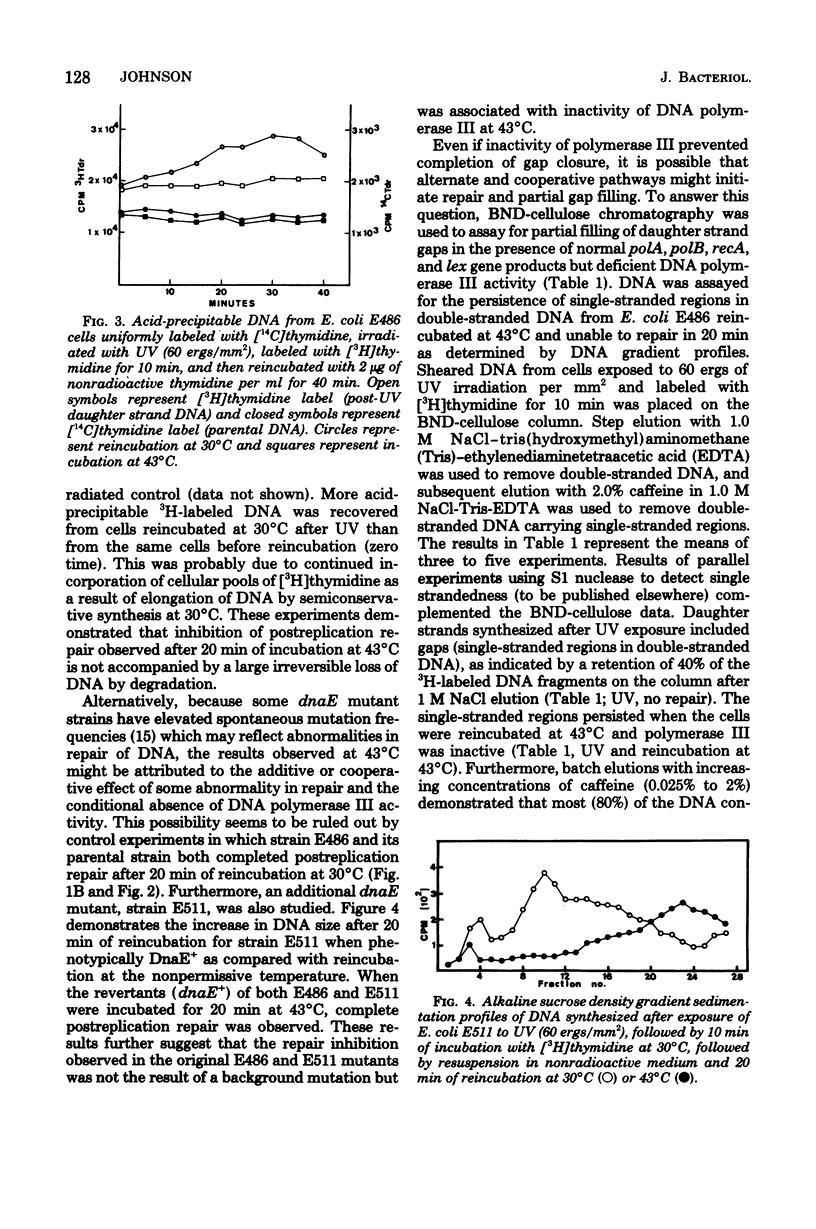
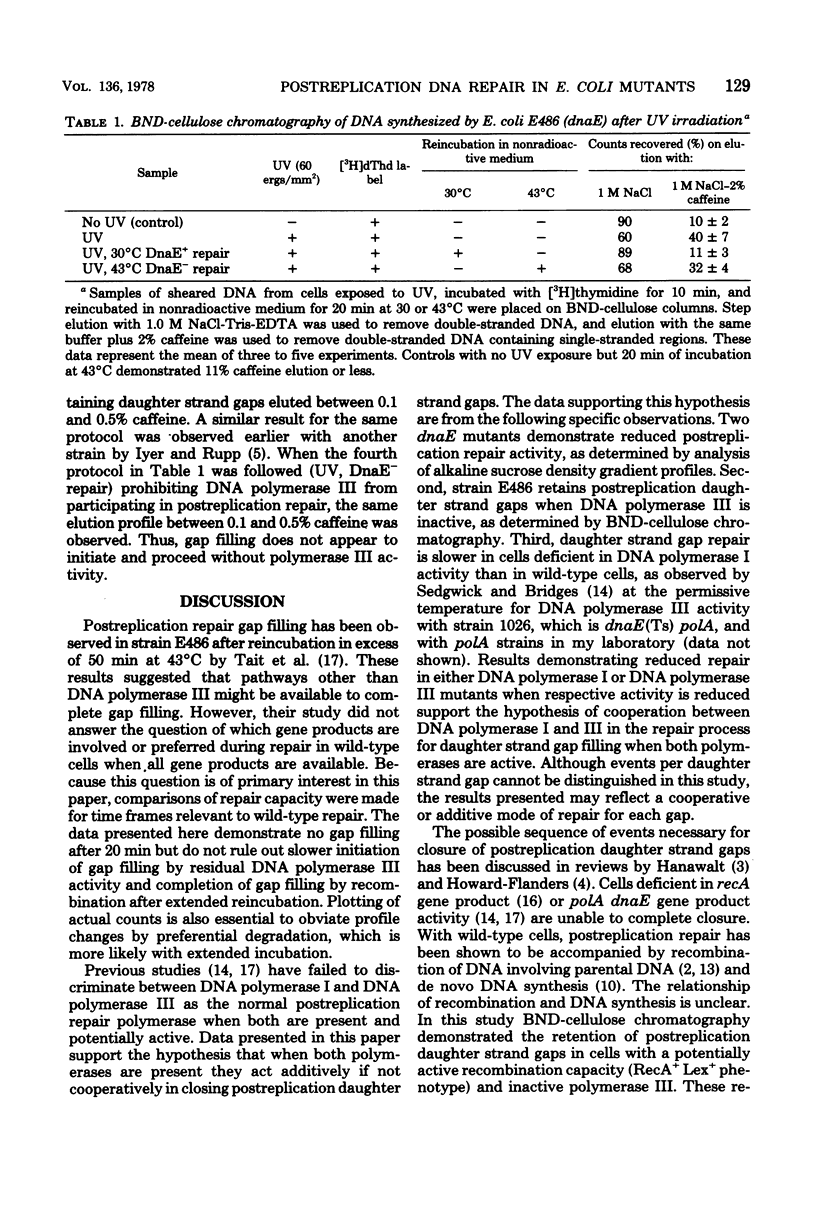
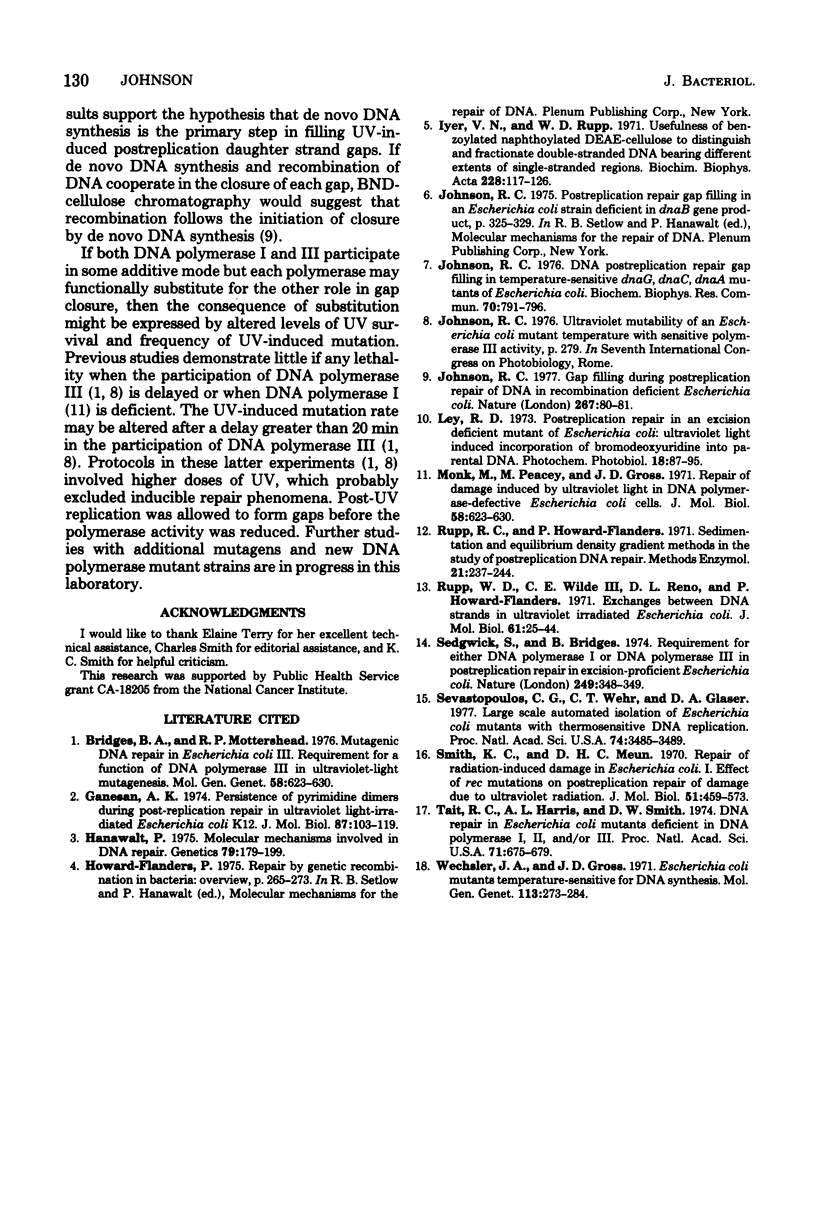
Selected References
These references are in PubMed. This may not be the complete list of references from this article.
- Ganesan A. K. Persistence of pyrimidine dimers during post-replication repair in ultraviolet light-irradiated Escherichia coli K12. J Mol Biol. 1974 Jul 25;87(1):103–119. doi: 10.1016/0022-2836(74)90563-4. [DOI] [PubMed] [Google Scholar]
- Hanawalt P. C. Molecular mechanisms involved in DNA repair. Genetics. 1975 Jun;79 (Suppl):179–197. [PubMed] [Google Scholar]
- Howard-Flanders P. Repair by genetic recombination in bacteria: overview. Basic Life Sci. 1975;5A:265–274. doi: 10.1007/978-1-4684-2895-7_35. [DOI] [PubMed] [Google Scholar]
- Iyer V. N., Rupp W. D. Usefulness of benzoylated naphthoylated DEAE-cellulose to distinguish and fractionate double-stranded DNA bearing different extents of single-stranded regions. Biochim Biophys Acta. 1971 Jan 1;228(1):117–126. doi: 10.1016/0005-2787(71)90551-x. [DOI] [PubMed] [Google Scholar]
- Johnson R. C. DNA postreplication repair gap filling in temperature-sensitive dnaG, dnaC, dnaA mutants of Escherichia coli. Biochem Biophys Res Commun. 1976 Jun 7;70(3):791–796. doi: 10.1016/0006-291x(76)90661-6. [DOI] [PubMed] [Google Scholar]
- Johnson R. C. Gap filling during postreplication repair of DNA in recombination deficient Escherichia coli. Nature. 1977 May 5;267(5606):80–81. doi: 10.1038/267080a0. [DOI] [PubMed] [Google Scholar]
- Johnson R. C. Postreplication repair gap filling in an Escherichia coli strain deficient in dnaB gene product. Basic Life Sci. 1975;5A:325–329. doi: 10.1007/978-1-4684-2895-7_44. [DOI] [PubMed] [Google Scholar]
- Ley R. D. Postreplication repair in an excision-defective mutant of Escherichia coli: ultraviolet light-induced incorporation of bromodeoxyuridine into parental DNA. Photochem Photobiol. 1973 Aug;18(2):87–95. doi: 10.1111/j.1751-1097.1973.tb06397.x. [DOI] [PubMed] [Google Scholar]
- Monk M., Peacey M., Gross J. D. Repair of damage induced by ultraviolet light in DNA polymerase-defective Escherichia coli cells. J Mol Biol. 1971 Jun 14;58(2):623–630. doi: 10.1016/0022-2836(71)90376-7. [DOI] [PubMed] [Google Scholar]
- Rupp W. D., Wilde C. E., 3rd, Reno D. L., Howard-Flanders P. Exchanges between DNA strands in ultraviolet-irradiated Escherichia coli. J Mol Biol. 1971 Oct 14;61(1):25–44. doi: 10.1016/0022-2836(71)90204-x. [DOI] [PubMed] [Google Scholar]
- Sedgwick S. G., Bridges B. A. Requirement for either DNA polymerase I or DNA polymerase 3 in post-replication repair in excision-proficient Escherichia coli. Nature. 1974 May 24;249(455):348–349. doi: 10.1038/249348a0. [DOI] [PubMed] [Google Scholar]
- Sevastopoulos C. G., Wehr C. T., Glaser D. A. Large-scale automated isolation of Escherichia coli mutants with thermosensitive DNA replication. Proc Natl Acad Sci U S A. 1977 Aug;74(8):3485–3489. doi: 10.1073/pnas.74.8.3485. [DOI] [PMC free article] [PubMed] [Google Scholar]
- Smith K. C., Meun D. H. Repair of radiation-induced damage in Escherichia coli. I. Effect of rec mutations on post-replication repair of damage due to ultraviolet radiation. J Mol Biol. 1970 Aug;51(3):459–472. doi: 10.1016/0022-2836(70)90001-x. [DOI] [PubMed] [Google Scholar]
- Tait R. C., Harris A. L., Smith D. W. DNA repair in Escherichia coli mutants deficient in DNA polymerases I, II and-or 3. Proc Natl Acad Sci U S A. 1974 Mar;71(3):675–679. doi: 10.1073/pnas.71.3.675. [DOI] [PMC free article] [PubMed] [Google Scholar]
- Wechsler J. A., Gross J. D. Escherichia coli mutants temperature-sensitive for DNA synthesis. Mol Gen Genet. 1971;113(3):273–284. doi: 10.1007/BF00339547. [DOI] [PubMed] [Google Scholar]


